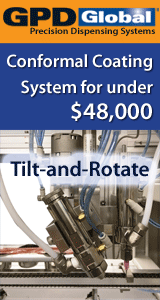Developments in Electroless Copper Processes to Improve Performance in amSAP Mobile Applications
Published: |
September 2, 2020 |
Author: |
Stefanie Bremmert, Laurence Gregoriades, Kay Wurdinger, Thomas Vágó, Tobias Bernhard, Frank Bruning, Roger Massey |
Abstract: |
With the adoption of Wafer Level Packages (WLP) in the latest generation mobile handsets, the Printed Circuit Board (PCB) industry has also seen the initial steps of High Density Interconnect (HDI) products migrating away from the current subtractive processes towards a more technically adept technique, based on an advanced modified Semi Additive Process (amSAP). This pattern plate process enables line and space features in the region of 20um to be produced, in combination with fully filled, laser formed microvias. However, in order to achieve these process demands, a step change in the performance of the chemical processes used for metallization of the microvia is essential. In the electroless Copper process, the critical activator step often risks cross contamination by the preceding chemistries. Such events can lead to uncontrolled buildup of Palladium rich residues on the panel surface, which can subsequently inhibit etching and lead to short circuits between the final traces. In addition, with more demands being placed on the microvia, the need for a high uniformity Copper layer has become paramount, unfortunately, as microvia shape is often far from ideal, the deposition or "throw" characteristics of the Copper bath itself are also of critical importance. This "high throwing power" is influential elsewhere in the amSAP technique, as it leads to a thinner surface Copper layer, which aids the etching process and enables the ultra-fine features being demanded by today's high end PCB applications. This paper discusses the performance of an electroless Copper plating process that has been developed to satisfy the needs of challenging amSAP applications. Through the use of a radical predip chemistry, the formation, build up and deposition of uncontrolled Pd residues arising from activator contamination has been virtually eradicated. With the adoption of a high throwing power Copper bath, sub 30um features are enabled and microvia coverage is shown to be greatly improved, even in complex via shapes which would otherwise suffer from uneven coverage and risk premature failure in service. Through a mixture of development and production data, this paper aims to highlight the benefits and robust performance of the new electroless Copper process for amSAP applications... |
|
|
|
Company Information:
- Nov 15, 2020 - Designing a High Performance Electroless Nickel and Immersion Gold to Maximize Highest Reliability
- Mar 12, 2020 - Filling of Microvias and Through Holes by Electrolytic Copper Plating –Current Status and Future Outlook
- Sep 19, 2019 - How Detrimental Production Concerns Related to Solder Mask Residues Can Be Countered by Simple Operational Adaptations
- Apr 10, 2019 - Soldering Immersion Tin
- Apr 20, 2017 - High Throw Electroless Copper - Enabling new Opportunities for IC Substrates and HDI Manufacturing
- See all SMT / PCB technical articles from Atotech »
More SMT / PCB assembly technical articles »
- Apr 11, 2022 - iNEMI Webinar 07.07.2021 - PCB Cleaning | ZESTRON Americas

- Jan 28, 2022 - Open Radio Unit White Box 5G | Whizz Systems

- Nov 10, 2021 - Understanding the Cleaning Process for Automatic Stencil Printers | ITW EAE

- Oct 20, 2021 - PCB Surface Finishes & The Cleaning Process - A Compatibility Study | ZESTRON Americas

- Oct 06, 2021 - Cleaning Before Conformal Coating | ZESTRON Americas

- Browse Technical Library »
Developments in Electroless Copper Processes to Improve Performance in amSAP Mobile Applications article has been viewed 675 times







